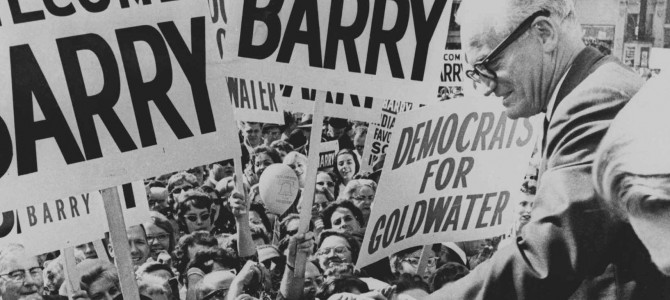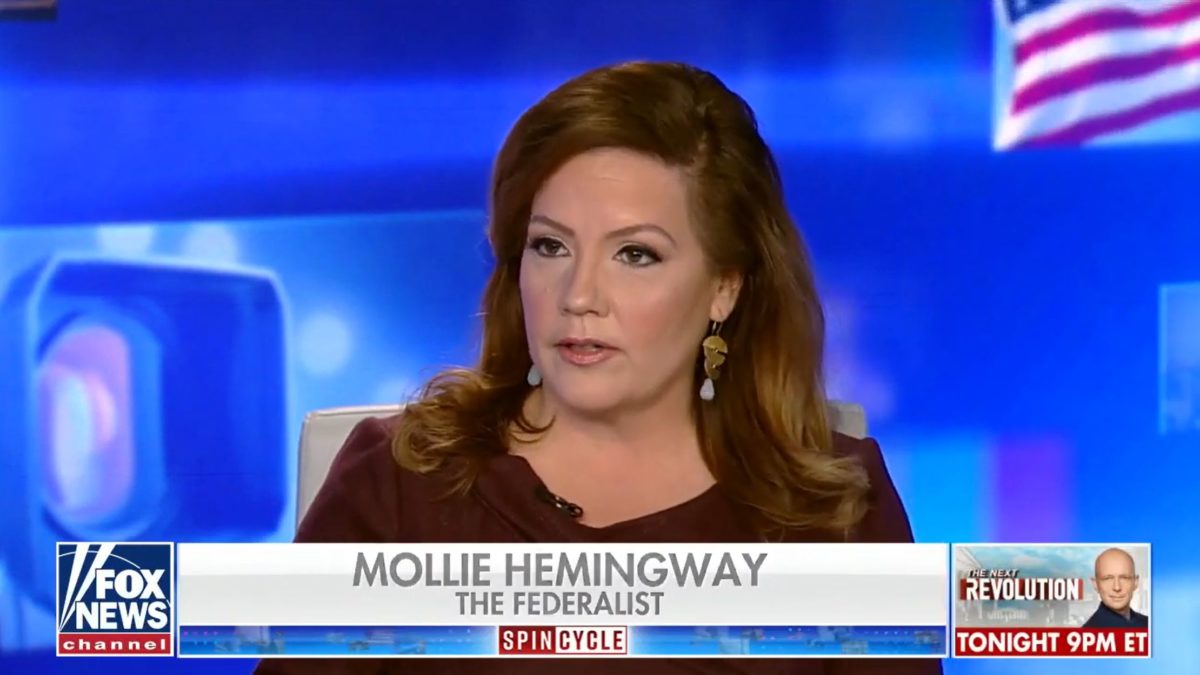
The last Republican presidential candidate to win California was George H.W. Bush, back in 1988. Last week, George Will suggested that a new sort of “Goldwater 2.0” conservatism, represented by the state’s Republican gubernatorial nominee Neel Kashkari, might at least color the state purple and force Democrats to fight, once again, for its 55 electoral college votes.
What is Goldwater 2.0? A mixture of an immigrant upbringing, a job at Goldman Sachs, a first-hand view of bailing out banks ‘too big to fail’ while working under Treasury Secretary Henry Paulson, a non-threatening pro-choice and pro-same sex marriage social libertarianism, and apparently, an orientation in Will’s words toward “discerning silver linings on black clouds.”
While Goldwater’s own brand of conservatism certainly evolved after the 1964 presidential race, Kashkari’s 21st century conservative operating system is plenty different from the one that prompted Goldwater to proclaim in his (in)famous 1964 Republican acceptance speech: “Extremism in the defense of liberty is no vice, and moderation in the pursuit of justice is not a virtue.”
Such bold words spoken today by a conservative candidate might provoke a MSM-led 21st century Salem Witch Trial with Senator Harry Reid playing the part of chief inquisitor. But that’s just the point, some on the right argue: even a less radical conservatism, at least taken out of context, is a political liability. And as there’s no preventing those covering politics from taking it out of context, better to blend in with the political culture of the day (a very un-Goldwater sentiment) with a more libertarian conservatism, marketable to 21st century Americans.
It is unlikely Friedrick Hayek, godfather of contemporary libertarianism, would have been impressed. Appended to the end of his 1960 treatise The Constitution of Liberty is an essay entitled “Why I am Not a Conservative,” distinguishing his (classically) liberal alternative to progressive ideologies from a simple resistance to change, the fundamental mark, in his view, of “any conservatism which deserve to be called such.”
The problem with conservatism, according to Hayek, is that
by its very nature it cannot offer an alternative to the direction in which we are moving. It may succeed by its resistance to current tendencies in slowing down undesirable developments, but, since it does not indicate another direction, it cannot prevent their continuance. It has, for this reason, invariably been the fate of conservatism to be dragged along a path not of its own choosing. The tug of war between conservatives and progressives can only affect the speed, not the direction, of contemporary developments.
By this description, the Establishment Republican is a model conservative, offering to run the welfare state for ninety-seven waste-cutting cents on the dollar, tempering hyper-regulation with responsible cost-benefit analysis, and posing as the clear-eyed adult in every political room.
But so, in its own way, is the Goldwater 2.0 conservative, following a pace and a half behind Progressive libertines on the one hand, while reconciling himself to the entrenched safety-first corporatism of the Wall Street-Washington ruling class, on the other.
Hayek notes that his analysis applies somewhat differently in describing the American political scene. Resistance to change in the United States can still mean resistance to departures from a liberal tradition–and, therefore, a defense (at least implicitly) of the principles Hayek himself advocates. He nevertheless concludes that the
difference between liberalism and conservatism must not be obscured by the fact that in the United States it is still possible to defend individual liberty by defending long-established institutions. To the liberal they are valuable not mainly because they are long established or because they are American but because they correspond to the ideals which he cherishes.
Here Hayek demonstrates the limits to his own vision: the alternative to defending “long-established” institutions because they are old or because they are ours is defending them because they are mine–i.e. they correspond to the “ideals” I cherish–ironically substituting one form of subjectivism for another.
Is there no better alternative to Progressivism?
Richard Weaver, a contemporary of Hayek, noted the sort of conservatism Hayek found in the me-too politician. But he argued (in The Ethics of Rhetoric) that “the true conservative is one who sees the universe as a paradigm of essences, of which the phenomenology of the world is a sort of continuing approximation.” In other words, the conservative is committed first to truth, not tradition–to the ideal because it is the ideal, not because it is something he cherishes.
While the Progressive wishes to reconstitute nature, the Weaver’s conservative submits to it. His political program, depending upon circumstances and the dictates of prudence, may be more or less consonant with the status quo, but its ultimate aim is always a fuller expression of human self-government within the God-given order of things.
Such conservatives offer a true, root-and-branch alternative to Progressivism– and can also give a better defense of the American founding than either Hayek’s liberal or his conservative, in part because the leading American founders were, themselves, just such conservatives.
This is evident, ironically, in the most troubling task executed by Publius in The Federalist: a defense of the three-fifths clause, which assigned representatives in the House to the states based upon the sum of “the Whole number of Free Persons” and “three fifths of all other Persons [i.e. slaves].”
James Madison’s Federalist 54 case for the three-fifths clause is complicated by the fact that the defense is presented in the voice of a hypothetical southerner, rather than that of Publius. Of course, Madison in actual fact was a southerner, who had voted in favor of the three-fifths clause in the Convention (albeit as a compromise), not the common citizen of New York that Publius pretended to be.
What is most striking in the essay, however, is how Madison’s southerner demonstrates the unnaturalness of slavery even while defending the clause. He speaks of the “pretext” that “the laws have transformed” the slaves “into subjects of property” as the only grounds for excluding their full number from the population count. The slaves have been “debased by servitude” and the law “which regards” them as “divested” of two-fifths of their manhood by partially considering them “in the unnatural light of property.”
One cannot be “debased” by slavery or “divested” of part of one’s manhood unless, in the light of nature, one is rightfully free and as equally a man as any counted fully in the population computation. The rule of the founding, Madison suggests even here, is the natural one: freedom and equality; slavery is but the aberrant exception, though one the founders were prepared to tolerate for a time. That temporary compromise came with the danger that some might move further away rather than closer to the natural standard–as indeed happened in antebellum America.
Recognizing this, Abraham Lincoln fought to reestablish the original meaning and implications of the founders’ most famous claim: “all men are created equal.” When the majority of the Supreme Court said that these words could have only been intended to apply to whites, Lincoln argued that their reach was universal, despite the obvious inconsistency between the founders’ “proposition” and their practice:
They did not mean to assert the obvious untruth, that all were then actually enjoying that equality, nor yet, that they were about to confer it immediately upon them. In fact they had no power to confer such a boon. They meant simply to declare the right, so that the enforcement of it might follow as fast as circumstances should permit. They meant to set up a standard maxim for free society, which should be familiar to all, and revered by all; constantly looked to, constantly labored for, and even though never perfectly attained, constantly approximated, and thereby constantly spreading and deepening its influence, and augmenting the happiness and value of life to all people of all colors everywhere.
The conservative case for the principles of the American founding is neither that they are old, nor that they American, nor that they are congenial to our prejudices, but that they are right and, in their implications, good, a reliable rallying point for reformation toward a better common life, challenging our (and their) compromises with justice.
The corollary, however, is this: a conservatism that redefines fundamentals like marriage or the scope of the human family (to justify abortion)–is no conservatism at all. The great political danger is that “Goldwater 2.0” will lead quickly to a Goldwater 3.0, 4.0, etc., discovering new implications of social libertarianism in the next refinement of polite (progressive) opinion.
Goldwater, as Will notes, won a victory in defeat in 1964, reshaping his party and, in part, the politics of the nation for a generation to come. Following Goldwater 2.0 is much more likely to lead to a defeat in victory, saving perhaps the Republican Party, but doing little to revitalize the American republic.
David Corbin is a Professor of Politics and Matthew Parks an Assistant Professor of Politics at The King’s College, New York City. They are co-authors of “Keeping Our Republic: Principles for a Political Reformation” (2011). You can follow their work on Twitter or Facebook.









